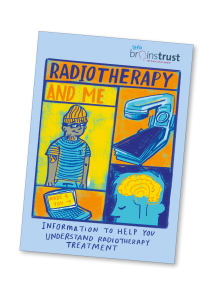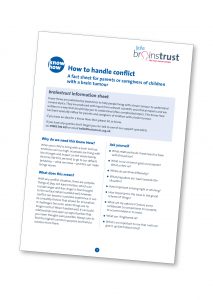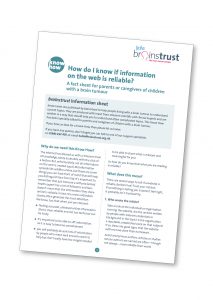Radiotherapy And Me: our new guide to help children and young people feel resourced and prepared for their treatment
After being diagnosed with a brain tumour, children and teenagers feel scared, and their carers isolated. In the time following diagnosis, you receive overwhelming amounts of information which at the time is hard to process. You don’t have to do this alone.
Our resources and support are your disposal so that you feel better resourced, less alone and more in control. The newest addition to our little brainstrust resource library has been written to help children and young people understand radiotherapy.
Reducing anxiety around radiotherapy for children and young people
 The newest addition to our little brainstrust library is our Radiotherapy And Me guide. It is designed with teenagers, young people and parents in mind. The guide helps young people understand what to expect when they have radiotherapy, so they feel less anxious and more prepared for treatment.
The newest addition to our little brainstrust library is our Radiotherapy And Me guide. It is designed with teenagers, young people and parents in mind. The guide helps young people understand what to expect when they have radiotherapy, so they feel less anxious and more prepared for treatment.
The guide covers:
- How a brain tumour is treated
- Questions to ask the clinical team
- What is radiotherapy
- Do you need radiotherapy
- How radiotherapy works
- Radiotherapy treatment process
- Side effects from radiotherapy
- Radiotherapy for brain and spinal tumours
- Other types of radiotherapy
- Reading list
- Illustrated glossary
 Written in accordance with brainstrust’s rigorous production and review process, with the input of expert healthcare professionals, patients and caregivers, Radiotherapy And Me is informative without being intimidating – so young people with a brain tumour feel prepared for radiotherapy treatment.
Written in accordance with brainstrust’s rigorous production and review process, with the input of expert healthcare professionals, patients and caregivers, Radiotherapy And Me is informative without being intimidating – so young people with a brain tumour feel prepared for radiotherapy treatment.
This guide was illustrated by Sarah Smizz, an artist, researcher and qualified therapeutic radiographer. She is passionate about making healthcare information accessible, engaging and compassionate.
You can read Radiotherapy And Me online here or email hello@brainstrust.org.uk to request a hard copy. If you are a healthcare professional, you can bulk order hard copies of the guide here.
Other resources for families when a child or young person is diagnosed with a brain tumour
Many of our resources can be found our website. A good starting point would be to order a brain box which will be tailored for you and your family. Below are resources specifically designed for families when a child is diagnosed with a brain tumour.
Who’s who: children and teens medical team
This Who’s Who is designed for parents, children and teenagers to gain an insight into what the role of each professional is.
Download the Who’s who: Children and teenagers’ medical team
How to deal with overwhelm
When situations change, it is hard to know which way to turn. Things that you did so easily
suddenly become overwhelming. Some things are within your power to change. Some are not. This Know How is designed to help you understand the difference, and prioritise the things that you can have an impact on.
Download the How to deal with overwhelm Know How
Cannabinoids
This Know How is intended to bring some clarity to a confusing topic. Medicinal cannabis is a broad term for any sort of cannabis-based medicine used to relieve symptoms. There are many mixed messages about cannabis in the media and within the brain tumour community. Many cannabis based products are available to buy online, but their quality and content is not known. They may be illegal and potentially dangerous. Certain things inside cannabis contain anticancer properties, but this does not make it an anticancer treatment.
Download the Cannabinoids Know How
How to get a second opinion
We are often asked about second or even third opinions. Seeking more opinions has both advantages and disadvantages. This Know How has been designed to help you understand the pros and cons of a second opinion, bring some clarity as to what the options are and inform you how to go about seeking another opinion.
Download the How to get a second opinion Know How
How to handle conflict
When you are living with a brain tumour, emotions can run high, as people are living with stress. At times like this, we tend to go to our default behaviour – what we know – and this can make things worse. This Know How will help you understand how to handle conflict, and try and turn it into something productive.
Download the How to handle conflict Know How
Reliable websites
Access to the internet at the tips of our fingers has made getting hold of information quicker and easier than ever, but how can you know what sources to trust? Misinformation spreads fast online, and is sometimes shared by people with a large following.
This Know How will help you to understand what reliable websites look like, establish fact from fiction online and stop feeling overwhelmed by the volume of information available.
Download the Reliable websites Know How
All our resources mentioned above are available as hard copies, if you are a patient or caregiver please email or call 01983 292 405 to order a hard copy.
Healthcare professionals you can bulk order our resources on our shop.
We are always looking to grow our information resources, so if you have an idea get in touch by email or call 01983 292 405.















